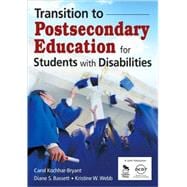
Note: Supplemental materials are not guaranteed with Rental or Used book purchases.
Purchase Benefits
Looking to rent a book? Rent Transition to Postsecondary Education for Students With Disabilities [ISBN: 9781412952798] for the semester, quarter, and short term or search our site for other textbooks by Carol Kochhar-Bryant. Renting a textbook can save you up to 90% from the cost of buying.
| About the Authors | p. ix |
| Introduction | p. 1 |
| National Focus on Postsecondary Transition | p. 1 |
| Postsecondary Options for Youth With Disabilities | p. 2 |
| Facing Many Questions About Postsecondary Choices | p. 2 |
| Purpose of the Book | p. 5 |
| Who Is the Student in Transition to Postsecondary? | p. 9 |
| Introduction | p. 9 |
| Who Participates in Postsecondary Options? Participation in and Outcomes of Postsecondary Education | p. 10 |
| Adolescent Development, Career Counseling, and Postsecondary Choices | p. 16 |
| What Changes as the Student Moves From the Secondary to the Postsecondary World? | p. 23 |
| Introduction | p. 23 |
| What Is Different for the Student in the Postsecondary World? | p. 24 |
| What Strategies Assist Youth With Transition to Postsecondary Education? | p. 27 |
| Concept of "Supported Education" | p. 29 |
| How Does IDEA 2004 Promote Postsecondary Participation? Collaboration and the Summary of Performance | p. 30 |
| What Strategies Assist Youth With Transition to Employment? | p. 32 |
| Self-Determination and Self-Advocacy Skills Essential for Successful Transition to Postsecondary Settings | p. 39 |
| Introduction | p. 39 |
| What Is Self-Determination? | p. 40 |
| How Can Students Learn Self-Determination Skills for Postsecondary Education? | p. 44 |
| What Can Schools and Professionals Do to Assist Students? | p. 52 |
| How Can School Professionals Assist in Students' Transition to Postsecondary Education? | p. 53 |
| Guided Pathways: Colleges and Universities | p. 55 |
| Introduction | p. 55 |
| What Factors Are Essential to Help Students as They Consider Attending College? | p. 56 |
| How Do Students Make Postsecondary Choices? | p. 60 |
| How Can Students Prepare for Postsecondary Coursework in Their High School Years? | p. 60 |
| How Do Students Prepare to Attend Postsecondary Institutions? | p. 65 |
| Guided Pathways: Career-Technical Education | p. 71 |
| Introduction | p. 71 |
| Federal Laws and Eligibility for Career-Technical Education | p. 75 |
| Origins of Career-Technical Education | p. 78 |
| Career Education Becomes a National Priority and Includes Special Populations | p. 79 |
| Planning for Transition for Students with Disabilities | p. 89 |
| Career and Technical Course Accommodations/Modifications | p. 95 |
| Assessment for Planning and Transition | p. 97 |
| Postsecondary and Workplace Accommodations | p. 101 |
| Focus on the Year After High School | p. 105 |
| Introduction | p. 105 |
| Transition to Self-Determined Decisions | p. 106 |
| Transition to Self-Advocacy | p. 113 |
| Transition to College Services | p. 115 |
| Transition to College Learning | p. 119 |
| Closing Thoughts | p. 127 |
| Role of Community Agencies in Supporting the Transition to Postsecondary Education | p. 129 |
| Introduction | p. 129 |
| What Is the Role of Community Agencies in Supporting Transition to Postsecondary? | p. 131 |
| What Agencies or Services Are Available to Assist Students in Making a Successful Transition to Postsecondary Education? | p. 135 |
| What Agency Services Are Provided and Who Are the Professionals Who Provide Them? | p. 136 |
| How Do Students Access Agency Services? | p. 139 |
| How Does the Postsecondary Student Access Services From Vocational Rehabilitation? | p. 140 |
| What Is the Role of the Local Interagency Transition Planning Council? | p. 143 |
| Getting Started Building a Community Transition Team | p. 144 |
| Student Voices | p. 147 |
| Introduction | p. 147 |
| Voices from Current Students | p. 149 |
| Deciding | p. 150 |
| Planning | p. 155 |
| Preparing | p. 159 |
| Exploring | p. 164 |
| Selecting | p. 167 |
| Applying | p. 170 |
| Enrolling | p. 172 |
| Considerations for Students with Specific Disabilities | p. 177 |
| Introduction | p. 177 |
| Students With Learning Disabilities | p. 178 |
| Students With Attention Deficit Hyperactivity Disorder or Attention Deficit Disorder | p. 181 |
| Students Who Have Chronic Diseases or Medical Conditions | p. 183 |
| Students With Emotional Disabilities or Mental Illnesses | p. 185 |
| Students Who Are Deaf or Hard of Hearing | p. 187 |
| Students Who Are Blind or Have Low Vision | p. 189 |
| Students With Autism Spectrum Disorders | p. 191 |
| Final Thoughts | p. 191 |
| Resource A | p. 194 |
| References | p. 210 |
| Index | p. 232 |
| Table of Contents provided by Ingram. All Rights Reserved. |
The New copy of this book will include any supplemental materials advertised. Please check the title of the book to determine if it should include any access cards, study guides, lab manuals, CDs, etc.
The Used, Rental and eBook copies of this book are not guaranteed to include any supplemental materials. Typically, only the book itself is included. This is true even if the title states it includes any access cards, study guides, lab manuals, CDs, etc.